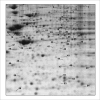Effect of long-term exposure of SH-SY5Y cells to morphine: a whole cell proteomic analysis
- PMID: 17184524
- PMCID: PMC1766345
- DOI: 10.1186/1477-5956-4-23
Effect of long-term exposure of SH-SY5Y cells to morphine: a whole cell proteomic analysis
Abstract
Background: Opiate addiction reflects plastic changes that endurably alter synaptic transmission within relevant neuronal circuits. The biochemical mechanisms of these adaptations remain largely unknown and proteomics-based approaches could lead to a broad characterization of the molecular events underlying adaptations to chronic drug exposure.
Results: Thus, we have started proteomic analyses of the effects of chronic morphine exposure in a recombinant human neuroblastoma SH-SY5Y clone that stably overexpresses the mu-opioid receptor. Cells were treated with morphine for 6, 24 and 72 hours, the proteins were separated by 2-D gel electrophoresis and stained with Coomassie blue, and the protein map was compared with that obtained from untreated cells. Spots showing a statistically significant variation were selected for identification using mass spectrometric analyses.
Conclusion: A total of 45 proteins were identified, including proteins involved in cellular metabolism, cytoskeleton organization, vesicular trafficking, transcriptional and translational regulation, and cell signaling.
Figures


Similar articles
-
Mu opiate receptor down-regulation by morphine and up-regulation by naloxone in SH-SY5Y human neuroblastoma cells.J Pharmacol Exp Ther. 1993 Apr;265(1):254-62. J Pharmacol Exp Ther. 1993. PMID: 8097244
-
Alterations in the expression of G-proteins and regulation of adenylate cyclase in human neuroblastoma SH-SY5Y cells chronically exposed to low-efficacy mu-opioids.Biochem J. 1993 Oct 1;295 ( Pt 1)(Pt 1):263-71. doi: 10.1042/bj2950263. Biochem J. 1993. PMID: 8216227 Free PMC article.
-
Morphine dependence in human neuroblastoma SH-SY5Y cells is associated with adaptive changes in both the quantity and functional interaction of PGE1 receptors and stimulatory G proteins.Brain Res. 1996 Jan 29;707(2):235-44. doi: 10.1016/0006-8993(95)01265-6. Brain Res. 1996. PMID: 8919301
-
Opioids: cellular mechanisms of tolerance and physical dependence.Curr Opin Pharmacol. 2005 Feb;5(1):60-8. doi: 10.1016/j.coph.2004.08.012. Curr Opin Pharmacol. 2005. PMID: 15661627 Review.
-
Reflections on: "A general role for adaptations in G-Proteins and the cyclic AMP system in mediating the chronic actions of morphine and cocaine on neuronal function".Brain Res. 2016 Aug 15;1645:71-4. doi: 10.1016/j.brainres.2015.12.039. Epub 2015 Dec 29. Brain Res. 2016. PMID: 26740398 Free PMC article. Review.
Cited by
-
Global changes in the rat heart proteome induced by prolonged morphine treatment and withdrawal.PLoS One. 2012;7(10):e47167. doi: 10.1371/journal.pone.0047167. Epub 2012 Oct 9. PLoS One. 2012. PMID: 23056601 Free PMC article.
-
Endogenous opiates and behavior: 2006.Peptides. 2007 Dec;28(12):2435-513. doi: 10.1016/j.peptides.2007.09.002. Epub 2007 Sep 11. Peptides. 2007. PMID: 17949854 Free PMC article. Review.
-
The ubiquitin-proteasome system and learning-dependent synaptic plasticity - A 10 year update.Neurosci Biobehav Rev. 2023 Sep;152:105280. doi: 10.1016/j.neubiorev.2023.105280. Epub 2023 Jun 12. Neurosci Biobehav Rev. 2023. PMID: 37315660 Free PMC article. Review.
-
Roles of the ubiquitin proteasome system in the effects of drugs of abuse.Front Mol Neurosci. 2015 Jan 6;7:99. doi: 10.3389/fnmol.2014.00099. eCollection 2014. Front Mol Neurosci. 2015. PMID: 25610367 Free PMC article. Review.
-
Postmortem proteomic analysis in human amygdala of drug addicts: possible impact of tubulin on drug-abusing behavior.Eur Arch Psychiatry Clin Neurosci. 2011 Mar;261(2):121-31. doi: 10.1007/s00406-010-0129-7. Epub 2010 Aug 5. Eur Arch Psychiatry Clin Neurosci. 2011. PMID: 20686780
References
LinkOut - more resources
Full Text Sources
Research Materials

